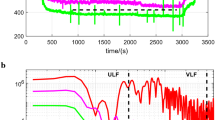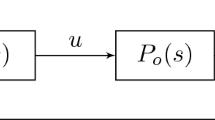Abstract
The aim of this study was to analyze the recovery of heart rate variability (HRV) after treadmill exercise and to investigate the autonomic nervous system response after exercise. Frequency domain indices, i.e., LF(ms2), HF(ms2), LF(n.u.), HF(n.u.) and LF/HF, and lagged Poincaré plot width (SD1 m ) and length (SD2 m ) were introduced for comparison between the baseline period (Pre-E) before treadmill running and two periods after treadmill running (Post-E1 and Post-E2). The correlations between lagged Poincaré plot indices and frequency domain indices were applied to reveal the long-range correlation between linear and nonlinear indices during the recovery of HRV. The results suggested entirely attenuated autonomic nervous activity to the heart following the treadmill exercise. After the treadmill running, the sympathetic nerves achieved dominance and the parasympathetic activity was suppressed, which lasted for more than 4 min. The correlation coefficients between lagged Poincaré plot indices and spectral power indices could separate not only Pre-E and two sessions after the treadmill running, but also the two sessions in recovery periods, i.e., Post-E1 and Post-E2. Lagged Poincaré plot as an innovative nonlinear method showed a better performance over linear frequency domain analysis and conventional nonlinear Poincaré plot.



Similar content being viewed by others
References
Billman GE (2011) Heart rate variability—a historical perspective. Front Physiol 2:86
Billman GE (2013) The LF/HF ratio does not accurately measure cardiac sympatho-vagal balance. Front Physiol 4:26
Boardman A, Schlindwein FS, Rocha AP, Leite A (2002) A study on the optimum order of autoregressive models for heart rate variability. Physiol Meas 23(2):325–336
Brennan M, Palaniswami M, Kamen P (2001) Do existing measures of Poincaré plot geometry reflect nonlinear features of heart rate variability? IEEE Trans Biomed Eng 48(11):1342–1347
Brennan M, Palaniswami M, Kamen P (2002) Poincaré plot interpretation using a physiological model of HRV based on a network of oscillators. Am J Physiol Heart Circ Physiol 283(5):H1873–H1886
Burr RL (2007) Interpretation of normalized spectral heart rate variability indices in sleep research: a critical review. Sleep 30(7):913–919
Carter JB, Banister EW, Blaber AP (2003) Effect of endurance exercise on autonomic control of heart rate. Sports Med 33(1):33–46
Casonatto J, Tinucci T, Dourado AC, Polito M (2011) Cardiovascular and autonomic responses after exercise sessions with different intensities and durations. Clinics (Sao Paulo) 66(3):453–458
Chen J-L, Yeh D-P, Lee J-P, Chen C-Y, Huang C-Y, Lee S-D, Chen C-C, Kuo TBJ, Kao C-L, Kuo C-H (2011) Parasympathetic nervous activity mirrors recovery status in weightlifting performance after training. J Strength Cond Res 25(6):1546–1552
Contreras P, Canetti R, Migliaro ER (2007) Correlations between frequency-domain HRV indices and lagged poincaré plot width in healthy and diabetic subjects. Physiol Meas 28(1):85–94
Dantas EM, Andreao RV, da Silva VJ, Ribeiro AL, Kemp AH, Brunoni AR, Lotufo PA, Rodrigues SL, Bensenor IM, Mill JG (2015) Comparison between symbolic and spectral analyses of short-term heart rate variability in a subsample of the ELSA-Brasil study. Physiol Meas 36(10):2119–2134
De Vito G, Galloway SDR, Nimmo MA, Maas P, McMurray JJV (2002) Effects of central sympathetic inhibition on heart rate variability during steady-state exercise in healthy humans. Clin Physiol Funct Imaging 22(1):32–38
Eckberg DL (1997) Sympathovagal balance: a critical appraisal. Circulation 96(9):3224–3232
Figueiredo T, Willardson JM, Miranda H, Bentes CM, Reis VM, Simao R (2015) Influence of load intensity on postexercise hypotension and heart rate variability after a strength training session. J Strength Cond Res 29(10):2941–2948
Figueroa A, Baynard T, Fernhall B, Carhart R, Kanaley JA (2007) Endurance training improves post-exercise cardiac autonomic modulation in obese women with and without type 2 diabetes. Eur J Appl Physiol 100(4):437–444
Francesco B, Maria Grazia B, Emanuele G, Valentina F, Sara C, Chiara F, Riccardo M, Francesco F (2012) Linear and nonlinear heart rate variability indexes in clinical practice. Comput Math Methods Med 2012:219080
Goshvarpour A, Goshvarpour A (2015) Poincaré indices for analyzing meditative heart rate signals. Biomed J 38(3):229–234
Guzik P, Piskorski J, Krauze T, Schneider R, Wesseling KH, Wykretowicz A, Wysocki H (2007) Correlations between the Poincaré plot and conventional heart rate variability parameters assessed during paced breathing. J Physiol Sci 57(1):63–71
Imai K, Sato H, Hori M, Kusuoka H, Ozaki H, Yokoyama H, Takeda H, Inoue M, Kamada T (1994) Vagally mediated heart rate recovery after exercise is accelerated in athletes but blunted in patients with chronic heart failure. J Am Coll Cardiol 24(6):1529–1535
Jurca R, Church TS, Morss GM, Jordan AN, Earnest CP (2004) Eight weeks of moderate-intensity exercise training increases heart rate variability in sedentary postmenopausal women. Am Heart J 147(5):e21
Kamen PW, Tonkin AM (1995) Application of the Poincare plot to heart rate variability: a new measure of functional status in heart failure. Aust N Z J Med 25(1):18–26
Kamen PW, Krum H, Tonkin AM (1996) Poincare plot of heart rate variability allows quantitative display of parasympathetic nervous activity in humans. Clin Sci (Lond) 91(2):201–208
Karmakar C, Jelinek HF, Khandoker A, Tulppo M, Makikallio T, Kiviniemi A, Huikuri H, Palaniswami M (2015) Multi-lag HRV analysis discriminates disease progression of post-infarct people with no diabetes versus diabetes. In: Conference Proceedings of IEEE Engineering Medical Biology Society 2015: 2367–2370
Kingsley JD, Hochgesang S, Brewer A, Buxton E, Martinson M, Heidner G (2014) Autonomic modulation in resistance-trained individuals after acute resistance exercise. Int J Sports Med 35(10):851–856
Kluttig A, Schumann B, Swenne CA, Kors JA, Kuss O, Schmidt H, Werdan K, Haerting J, Greiser KH (2010) Association of health behaviour with heart rate variability: a population-based study. BMC Cardiovasc Disord 10:58
Lerma C, Infante O, Perez-Grovas H, Jose MV (2003) Poincaré plot indexes of heart rate variability capture dynamic adaptations after haemodialysis in chronic renal failure patients. Clin Physiol Funct Imaging 23(2):72–80
Levy WC, Cerqueira MD, Harp GD, Johannessen KA, Abrass IB, Schwartz RS, Stratton JR (1998) Effect of endurance exercise training on heart rate variability at rest in healthy young and older men. Am J Cardiol 82(10):1236–1241
Lombardi F, Stein PK (2011) Origin of heart rate variability and turbulence: an appraisal of autonomic modulation of cardiovascular function. Front Physiol 2:95
Madden KM, Levy WC, Stratton JK (2006) Exercise training and heart rate variability in older adult female subjects. Clin Investig Med 29(1):20–28
Malliani A, Pagani M, Lombardi F, Cerutti S (1991) Cardiovascular neural regulation explored in the frequency domain. Circulation 84(2):482–492
Mendonca GV, Pereira FD, Fernhall B (2013) Heart rate recovery and variability following combined aerobic and resistance exercise training in adults with and without Down syndrome. Res Dev Disabil 34(1):353–361
Miyata TT, Oishi S, Taniguchi Y, Kawai H, Yasaka Y, Yokoyama H (2016) Power spectral analysis of heart rate variability during the postural change from sitting to upright position reveal sympathetic hyperactivity. Eur J Heart Fail 18(S1):407
Nardelli M, Valenza G, Greco A, Lanata A, Scilingo EP (2015) Arousal recognition system based on heartbeat dynamics during auditory elicitation. In: Conference Proceedings of IEEE Engineering Medical Biology Society 2015: 6110–6113
Pagani M, Lombardi F, Guzzetti S, Rimoldi O, Furlan R, Pizzinelli P, Sandrone G, Malfatto G, Dell’Orto S, Piccaluga E (1986) Power spectral analysis of heart rate and arterial pressure variabilities as a marker of sympatho-vagal interaction in man and conscious dog. Circ Res 59(2):178–193
Panda K, Krishna P (2014) Physical exercise and cardiac autonomic activity in healthy adult men. Indian J Physiol Pharmacol 58(4):365–370
Roy B, Ghatak S (2013) Nonlinear methods to assess changes in heart rate variability in type 2 diabetic patients. Arq Bras Cardiol 101(4):317–327
Saboul D, Balducci P, Millet G, Pialoux V, Hautier C (2016) A pilot study on quantification of training load: the use of HRV in training practice. Eur J Sport Sci 16(2):172–181
Stoggl T, Schwarzl C, Muller EE, Nagasaki M, Stoggl J, Schonfelder M, Niebauer J (2017) Alpine skiing as winter-time high-intensity training. Med Sci Sports Exerc. doi:10.1249/MSS.0000000000001289
Sun P, Yan H, Ranadive SM, Lane AD, Kappus RM, Bunsawat K, Baynard T, Hu M, Li S, Fernhall B (2016) Autonomic recovery is delayed in Chinese compared with caucasian following treadmill exercise. PLoS ONE 11(1):e0147104
Takalo R, Hytti H, Ihalainen H (2005) Tutorial on univariate autoregressive spectral analysis. J Clin Monit Comput 19(6):401–410
Tarvainen MP, Georgiadis SD, Ranta-Aho PO, Karjalainen PA (2006) Time-varying analysis of heart rate variability signals with a Kalman smoother algorithm. Physiol Meas 27(3):225–239
Task force of the European society of cardiology and the North American society of pacing and electrophysiology (1996) Heart rate variability: standards of measurement, physiological interpretation and clinical use. Circulation 93(5):1043–1065
Teixeira L, Ritti-Dias RM, Tinucci T, Mion Junior D, Forjaz CLdM (2011) Post-concurrent exercise hemodynamics and cardiac autonomic modulation. Eur J Appl Physiol 111(9):2069–2078
Thakre TP, Smith ML (2006) Loss of lag-response curvilinearity of indices of heart rate variability in congestive heart failure. BMC Cardiovasc Disord 6:27
Tulppo MP, Makikallio TH, Takala TE, Seppanen T, Huikuri HV (1996) Quantitative beat-to-beat analysis of heart rate dynamics during exercise. Am J Physiol 271(1 Pt 2):H244–H252
Voss A, Fischer C, Schroeder R, Figulla HR, Goernig M (2012) Lagged segmented Poincaré plot analysis for risk stratification in patients with dilated cardiomyopathy. Med Biol Eng Comput 50(7):727–736
Weippert M, Behrens K, Rieger A, Kumar M, Behrens M (2015) Effects of breathing patterns and light exercise on linear and nonlinear heart rate variability. Appl Physiol Nutr Metab 40(8):762–768
Wessel N, Riedl M, Kurths J (2009) Is the normal heart rate “chaotic” due to respiration? Chaos 19(2):028508
Wessel N, Sidorenko L, Kraemer JF, Schoebel C, Baumann G (2016) Assessing cardiac autonomic function via heart rate variability analysis requires monitoring respiration. Europace 18(8):1280
Zhang D, She J, Yang J, Yu M (2015) Linear and nonlinear dynamics of heart rate variability in the process of exposure to 3600 m in 10 min. Australas Phys Eng Sci Med 38(2):263–270
Acknowledgements
This work was supported by Innovation Program of Shanghai Municipal Education Commission (Grant No. 14YZ091).
Author information
Authors and Affiliations
Corresponding author
Ethics declarations
Conflict of interest
The authors declared that they have no conflict of interest.
Ethical approval
All procedures performed in studies involving human participants were in accordance with the ethical standards of the institutional and/or national research committee and with the 1964 Helsinki Declaration and its later amendments or comparable ethical standards. The study was approved by the ethics committee of University of Shanghai for Science and Technology, Shanghai, China (Ref. No. 2013-9023-14YZ091).
Rights and permissions
About this article
Cite this article
Shi, P., Hu, S. & Yu, H. Recovery of heart rate variability after treadmill exercise analyzed by lagged Poincaré plot and spectral characteristics. Med Biol Eng Comput 56, 221–231 (2018). https://doi.org/10.1007/s11517-017-1682-2
Received:
Accepted:
Published:
Issue Date:
DOI: https://doi.org/10.1007/s11517-017-1682-2




